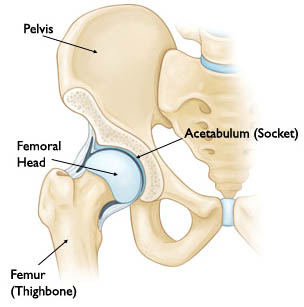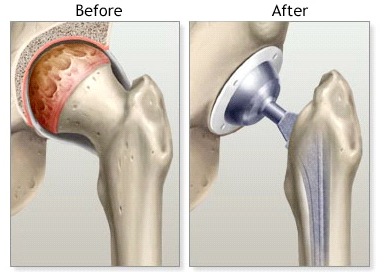Hip Replacement also called as Hip Arthroplasty, is a surgical procedure to remove painful hip joint with arthritis and replaced it with artificial parts. It is done as a partial or a total hip replacement surgery. Total Hip Replacement involves surgical removal of the diseased ball and socket and replacing them with a metal ball and stem inserted into the femur bone and an artificial plastic cup socket.
Hip Replacement Causes
 Total hip replacement is done when severe arthritis worsens in the hip joint. Osteoarthritis is one of the most common conditions that results in the need for hip replacement surgery. This type of arthritis majorly seen with aging, physical abnormality of the hip joint present from birth, or some prior injury to the hip joint.
Total hip replacement is done when severe arthritis worsens in the hip joint. Osteoarthritis is one of the most common conditions that results in the need for hip replacement surgery. This type of arthritis majorly seen with aging, physical abnormality of the hip joint present from birth, or some prior injury to the hip joint.
Some other conditions for hip replacement are.
- Avascular necrosis results from an inadequate supply of blood to the bone end inside the joint.
- Others: – Benign and malignant bone tumors can alter the shape and congruency of the joint and also disrupt blood supply of the joints, affecting articular cartilage.
- Post-traumatic arthritis, a type of arthritis that can arise following an injury to the joint cartilage or through damage to the ligaments leading to an unstable hip.
- Rheumatoid arthritis, an inflammation of the tissue surrounding the joints, can cause deterioration of cartilage and other parts of the joint and also result in the need for hip replacement.
Types
Traditional Hip Replacement
In a traditional surgery, the surgeon makes a 10-12 inches incision through some of the muscles around the hip. Then the surgeon removes the damaged bone and cartilage and replaces them with a prosthesis. The muscles are split from the hip allowing the hip to be dislocated and fully viewed. The affected femoral head (thigh bone) is removed and replaced with a metal stem that is placed into the hollow center of the femur, then a metal ball is placed on the upper part of the stem. This ball then replaces the affected femoral head that was removed. The damaged cartilage surface of the socket is removed and then replaced with a metal socket. Screws or cement hold the socket in joint place. Plastic, ceramic or metal spacer inserted between the new ball and the socket to allow a smooth gliding surface.
Minimally Invasive Surgery
In minimally invasive hip replacement, the surgical procedure is similar, but there are smaller incisions of the tissue surrounding the hip. Fewer incisions allow for less tissue disturbance. These incisions may be in the back, side, or front of the hip. The recovery time for the mini-incision surgery is less than that of traditional surgery.
Cost
The cost of surgery varies from $5,000 to $20,000 depending on other factors and one geographic area to another.
 Functioning Of Hip Joint:
Functioning Of Hip Joint:
The Hip is a ball and socket Joint comprised of the following structures:
- Head of the Femur
- Acetabulum of the Pelvis
- Ligaments of the Hip Joint
The head of the femur or ball of the Hip Joint articulates or moves within the cup-like socket called the acetabulum of the pelvic bone. Together, these structures also called as a ball and socket joint. A particular surface cover the femoral head and acetabulum called articular cartilage. It allows smooth and painless motion of the hip joint.
When Does One Need Hip Replacement Surgery?
The most common disease which leads to hip replacement is osteoarthritis in the hip joint. An orthopedic surgeon must be able to see damage to cartilage surrounding the joint area. Also, other indications for hip replacement include,
- Chronic pain in the hip joints
- No relief from pain medications
- Problem in day to day activities
- Pain during rising from a sitting position
- Have to stop activities because you are in too much hip pain
Benefits
- Effective Treatment: – Hip replacement surgery has proved as the most efficient treatment for Arthritis for countless patients throughout the world.
- Reduce pain: – Following the initial surgery-related discomfort, you should expect that your hip pain will either eliminated or significantly reduced.
- Restore lost mobility in hip joint: – As your hip pain subsides, your joint will become stronger. That means better mobility, less fatigue, and easier movements.
- Reliable Joint Surgery: – One of the most trusted operations in orthopedic surgery, that eliminates the pain of arthritis in patients.
- Improve your quality of life: – With less joint pain and greater mobility, you should be able to perform daily tasks more quickly and lead a more active life.





